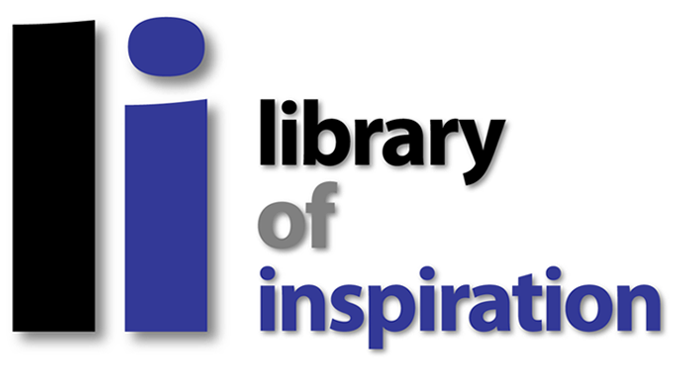| |
2010s |
| |
20,000 Days on Earth, Directed by Iain Forsyth and Jane Pollard
The Artist, Directed by Michel Hazanavicius
Blue is the Warmest Color, Directed by Abdellatif Kechiche
The Descendants, Directed by Alexander Payne
Exit Through the Gift Shop, Directed by Banksy
Force Majeure, Directed by Ruben Östlund
Holy Motors, Directed by Leos Carax
I Love You Phillip Morris, Directed by John Requa and Glenn Ficarra
It Follows, Directed by David Robert Mitchell
The Master, Paul Thomas Anderson
Midnight in Paris, Directed by Woody Allen
Museum Hours, Directed by Jem Cohen
Room 237, Directed by Rodney Ascher
The Tree of Life, Directed by Terrence Malick
Yossi, Directed by Eytan Fox |
|
|
Museum Hours, Directed by Jem Cohen
The Cinema Guild, June 28, 2013 (US)
Screenplay: Jem Cohen
Starring: Mary Margaret O’Hara and Bobby Sommer
Imagination should be reserved for wonder, not woe. It’s days like every single day this winter that I think about moving to a warmer climate. More snow and mind-numbing cold is on the way. Some see snow as pretty. I find it pretty blinding. All I can envision of late is the menacing man-hours required to shovel the shit up. And the taller the mounds get, the more grueling and backbreaking the ordeal. But if I move, will I miss it? Sure. Maybe. I guess. I do know that as a kid it was the best gift imaginable: a day off school with a winter wonderland of options. There was the vast new arsenal of ammunition for snowball fights aplenty (the fights to the death that end in a good stinging to the ears and numbing of the cheekbones). There was the serious rush of the neighborhood’s best sledding hills, runs that could be repeated on an infinite loop for as long as you wanted with no regard to even the most bitter temps. A block from our house was a pond where we skated and played hockey until dusk, sometimes later. Children at play are immune to cold or wet. At least that is how it was for us.
The Hunters in the Snow - Pieter Bruegel the Elder
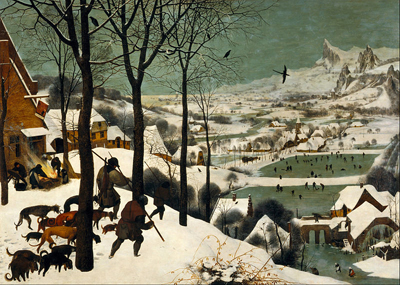
The painting shows a wintry scene in which three hunters are returning from an expedition accompanied by their dogs. By appearances the outing was not successful; the hunters appear to trudge wearily, and the dogs appear downtrodden and miserable. One man carries the “meagre corpse of a fox” illustrating the paucity of the hunt. The overall visual impression is one of a calm, cold, overcast day; the colors are muted whites and grays, the trees are bare of leaves, and woodsmoke hangs in the air. Several adults and a child prepare food at an inn with an outside fire.
The landscape itself is a flat-bottomed valley (a river meanders through it) with jagged peaks visible on the far side. A watermill is seen with its wheel frozen stiff. In the distance, figures ice skate, play hockey with modern style sticks and curl on a frozen lake; they are rendered as silhouettes.
-from the Wikipedia article, “The Hunters in the Snow”
“Things were easier then.” Frisbees, Wiffle ball, t-ball, baseball cards, bubble gum, flag football, two-hand touch, tennis, basketball, bowling, fishing, movies, marbles, paper airplanes, electric trains, ten-speeds, skateboards, roller skates, Slinkies, hide-and-seek, swimming pools, sprinklers, water balloons, pillow fights, Pac-Man, remote control cars.
Through a child’s eyes, the world holds no reason for constraints. Until responsibilities afford excuse to dismiss youthful perspective.
Children’s Games - Bruegel
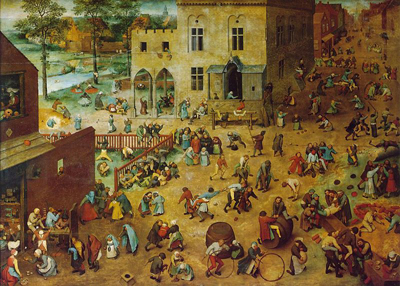
The artist’s intention for this work is more serious than simply to compile an illustrated encyclopaedia of children’s games, though some eighty particular games have been identified. Bruegel shows the children absorbed in their games with the seriousness displayed by adults in their apparently more important pursuits. His moral is that in the mind of God children’s games possess as much significance as the activities of their parents.
-from the Wikipedia article, “Children’s Games (Bruegel)”
Global temps are rising. Some storms are becoming scarily intense, downright horrific in their power, scope, and destruction. Polar vortex was not a term I was familiar with prior to this winter. Minus-40 wind chill in these parts is not only abnormal, it is obscene. I bundle my short-haired Boston Terrier up for as quick a walk as possible. Together, we brave the elements. While outside, I notice that once again, nobody in the condo association has bothered to shovel the latest dumping of snow. As soon as I let the dog back in, I will come right back out and rectify that. If I do not shovel, I worry that our cars will not make it out of the back alley. Forgive me for coming full circle to whine about weather. All roads lead me back.
The Return of the Herd - Bruegel
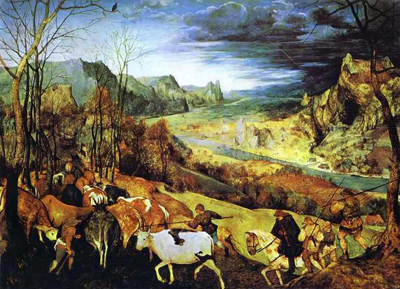
Note the painting’s clockwise movement and its thematic contrasts. There is movement not just of the river flowing downstream, but of the cattle moving ploddingly uphill. This resolves into the mountains’ march into the distance across the top, matched by the fold of the valley. One point of contrast is the ease of the water issuing downstream, against the visible effort of humans guiding their herd home, away from an inhospitable storm. The painting reminds us that human endeavor in working with nature for survival is a steady challenge. The mountains provide another contrast with their sharp, upward thrusts conveying a sense of timeless isolation, making a bleak backdrop to the farmers’ familiar, daily labors.
-from the Wikipedia article, “The Return of the Herd”
It is one thing to fantasize of slipping away for good to California or Florida. But such a goal is longer term at best and cannot lend any relief from current misery. There are other ways to escape that are far more immediate. Comfort food beckons. But that leads to wildly unhealthy allowances like downing a half of a package of Oreos in one sitting. In your head, your evil twin reminds that liquor is quicker. I glance at the bottle of Don Julio. But surely there are better avenues. As I am not in the mood for reading today, I decide my best bet is cinema. Scanning the iTunes library, a director’s name, Jem Cohen, catches my eye. I loved one of his previous films, Benjamin Smoke. It introduced me to Smoke and Opal Foxx Quartet: bands that make the kind of music that, if you’re not careful, may make you believe in a higher power. I decide to rent Cohen’s latest film, Museum Hours, in hopes it will take me to a similar place, although really anywhere but here will do just fine.
The Peasant Dance - Bruegel
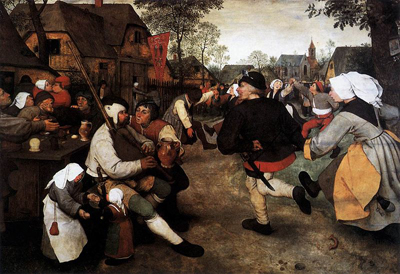
Like The Peasant Wedding, it is likely that Bruegel intended this painting to have a moral sense rather than simply being an affectionate portrayal of peasant life. Gluttony, lust and anger can all be identified in the picture. The man seated next to the bagpipe player wears a peacock feather in his hat, a symbol of vanity and pride.[4] The occasion for the peasants’ revelry is a saint’s day, but dancers turn their backs on the church and pay no attention whatsoever to the image of the Virgin which hangs on the tree. The prominence of the tavern makes it clear that they are preoccupied with material rather than spiritual matters.
-from the Wikipedia article, “The Peasant Dance”
-G

|
|
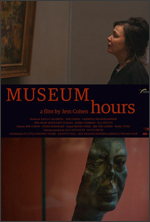 |
